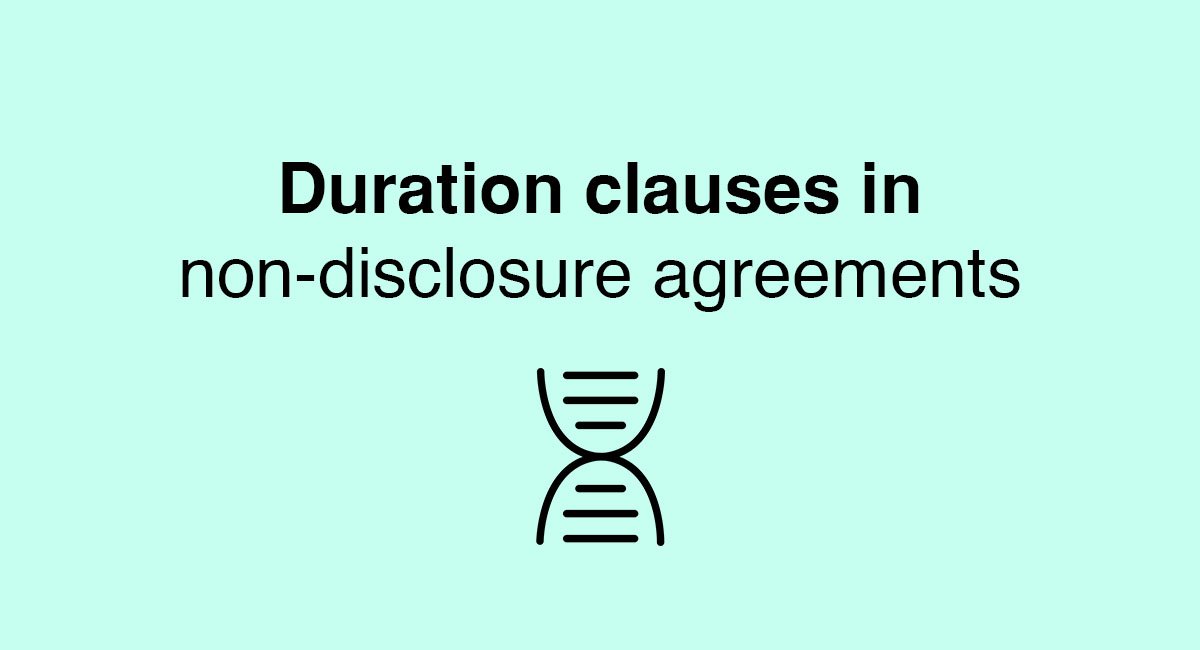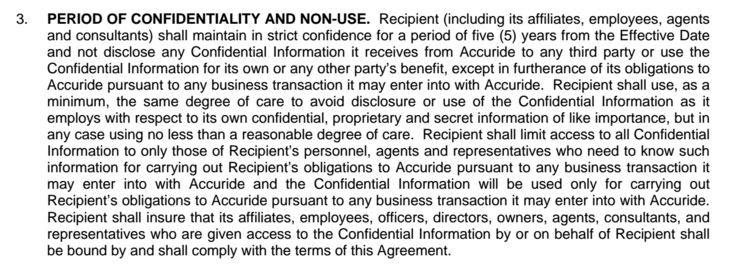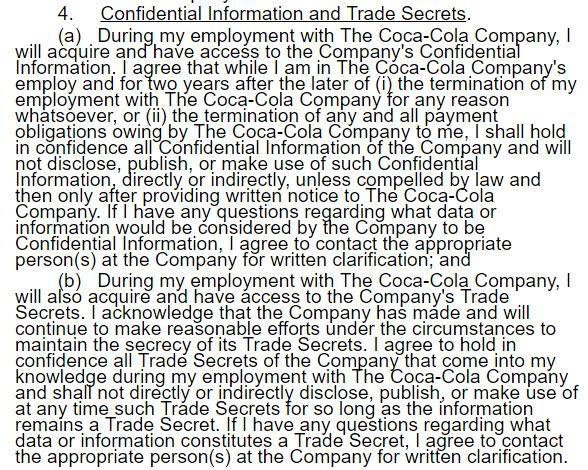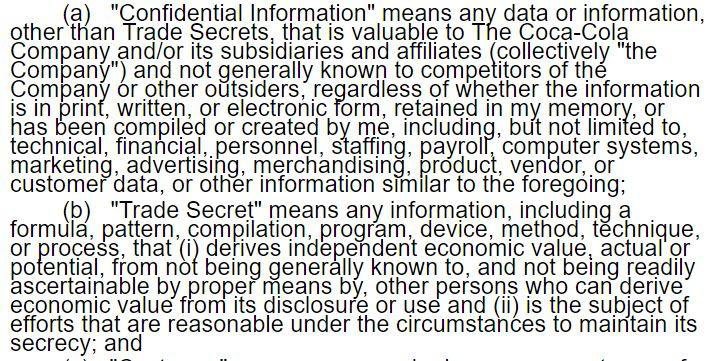Duration Clauses in Non-Disclosure Agreements

Non-disclosure agreements (NDAs, for short), also known as confidentiality agreements or trade secret agreements are legally binding contracts between parties with requirements to keep certain information confidential.
The non-disclosure agreements can be used to protect a wide range of confidential information including trade secrets.
Contents
Used between startups, individuals, small and medium-sized enterprises (SMEs) and larger corporations trying to establish a new business relationship or partnership with each other, these agreements can be used to maintain confidentiality of valuable disclosures and prevent misuse of such information.
Examples where non-disclosure agreements are commonly used are:
- In employer-employee hiring situations
- Between parties who are considering entering into a licensing agreement with each other
- Distribution relationships
- Between startups and companies who wish to test the potential possibility of beneficial commercial partnerships
- And so on
A non-disclosure agreement can go both ways or be only one-way.
A mutual non-disclosure is when both parties are making disclosures that need to be kept confidential by the other party whilst a one-way non-disclosure only requires that the party receiving the confidential information keeps secrecy.
In the event of a breach of confidentiality, these agreements can provide for both monetary remedies as well as injunctive relief to stop any further breaches from occurring.
When it comes to making sure that your non-disclosure will be upheld in a legal challenge, the scope of the agreement is extremely important in helping the courts to determine whether the terms of your non-disclosure agreement are reasonable or not.
Not all disclosures are created equal and not all disclosures might be considered confidential information.
As an example, here’s a Statement of Limited Purpose from Microsoft in its Confidentiality Agreements for Licensing Discussions to clarify what disclosures the agreement is meant to apply to:

Besides the scope of the agreement, courts also frequently consider whether the definition of what’s considered confidential is too broad.
Confidentiality can extend to documents, designs, sketches, analyses, source codes, marketing plans, manufacturing processes and technical procedures.
It’s up to the parties to decide what would be considered confidential and what’s not, but it should be justifiable by the Disclosing Party why something might be considered confidential.
Here’s an example of a clause defining what would be considered confidential for the parties in Accuride Corp’s Confidentiality and Non-Disclosure Agreement:

Another very important consideration for non-disclosure agreements is the time period for which it is meant to be enforceable.
There are generally 2 kinds of time periods for these agreements: perpetual or with a stated time limitation.
A perpetual non-disclosure agreement never expires whilst a non-disclosure agreement with a stated time limitation ceases to be active past the time period.
So which one should you use?
This comes down to the type of information that you’re trying to protect and the jurisdiction that will apply to your agreement.
There are generally two broad types of information that can be protected by a non-disclosure agreement: ordinary confidential information and trade secrets.
Ordinary Confidential Information
As mentioned earlier, confidential information can be defined broadly to cover everything from technical information to marketing information to customer lists and trade secrets.
Some confidential information may not need secrecy to extend beyond the end of the business relationship but others will require secrecy to continue to apply even after the termination of the business relationship.
There’s no one standard term but common confidentiality terms can range between 2, 3 and 5 years.
For the purposes of this section, let’s talk about ordinary confidential information that are not trade secrets.
When it comes to non-trade secret information, you have to be extremely cautious if you wish the obligation of confidentiality to extend indefinitely.
As a general rule, if you are merely trying to protect ordinary confidential information, it would be wiser to place a reasonable time duration for secrecy.
As some would argue, information such as customer lists, marketing strategies and pricing models may become obsolete after a few years anyway so there’s no reason to argue for a perpetual non-disclosure agreement if you are only dealing with ordinary confidential information.
Some countries have held that perpetual non-disclosures for confidential information can be acceptable if the impact of disclosure warrant it.
Other countries take a hard stance against anything that might come across as a restriction on competition.
In Lasership, Inc. v. Watson, the court in Virginia ruled that the non-disclosure agreement was unenforceable because the provisions that stopped the employee from sharing information about the employer covered information that weren’t confidential and also it was unreasonable for the provisions to apply indefinitely.
In Augusta Medical Complex, Inc. v. Blue Cross of Kansas, Inc., the Kansas court showed clear disfavor against contracts with indefinite time durations.
Another point to note is when the period of confidentiality is meant to begin.
There’s a difference between a time limitation for the agreement itself and a time limitation for when the disclosure is made. If a time limitation is applied to the agreement itself, that means that the clock starts ticking from the date of the agreement, not from when disclosure is made.
Here’s an example of a clause from Accuride Corp’s Confidentiality and Non-Disclosure Agreement that shows that the 5 year confidentiality period starts from the date of the agreement itself:

Contrast that with this clause from a Microsoft’s agreement where the 5 year period of confidentiality starts not from the date of the agreement but from the date that the disclosure is actually made:

Trade Secrets
Trade secrets are a special type of confidential information.
A trade secret has no time limitation and can last forever. It remains a trade secret indefinitely as long as you can prove that the secret continues to possess commercial value, confers some sort of economic benefit to you and you’ve made an effort to keep it a secret.
Trade secrets generally are essential to the commercial viability of a business. Businesses like Coca-Cola and KFC have managed to keep their trade secrets for 100 years and go to great lengths to protect their trade secrets, treating them with special attention.
For example, it has been a belief for decades that only two executives of Coca-Cola know the original secret Coca-Cola formula at any one point and that the original recipe is kept in a vault in Atlanta, Georgia.
KFC operates similarly in such a covert manner and only a handful of employees know its secret recipe of “11 herbs and spices” and reportedly, all these employees have signed confidentiality pledges.
According to reports on KFC, two companies are used to manufacture the secret recipe and each company is only given half of the recipe to prevent either company from knowing the full recipe.
Similarly, a trade secret is treated differently from ordinary confidential information by the courts.
A California court upheld the importance of confidentiality with trade secrets was the case of Pacesetter Inc. v. Nervicon Co. Ltd. where the prevailing party St. Jude Medical alleged that its trade secrets were stolen by the defendant and was awarded the amount of $2.3 billion which was later trimmed to $947 million.
Because trade secrets can last indefinitely, you should never place a time limitation on how long the secret is to be kept.
Never make the mistake of including a time limitation in your non-disclosure agreement for a trade secret because this would simply mean that the receiving party of your disclosure no longer has to keep your trade secret confidential after the time duration for secrecy has passed.
In the case of Silicon Image, Inc. v. Analogk Semiconductor, Inc. where Silicon Image made the mistake of copying the practice of other technology companies of providing a time limitation in its non-disclosure agreement which would have been fine except that Silicon Image was also disclosing trade secrets and found that it couldn’t enforce continued secrecy of its trade secrets after the time limitation of the non-disclosure ended.
If you only intend to disclose trade secrets, then it would be reasonable for you to include a clause that requires perpetual confidentiality.
However, as is normally the case, if you intend to make a combination of both trade secret disclosures and ordinary confidential information, then you have two alternatives.
If your non-disclosure is going to be in a jurisdiction where perpetual agreement are accepted by the courts, then you can choose not to have any time limitation in your agreement at all.
However, if your non-disclosure agreement will be covered by a jurisdiction where perpetual agreement are generally not looked upon favorably, then it would be better if you have two separate clauses to cover the disclosure time period required for ordinary confidential information and trade secrets.
Here is an example clause from Coca-Cola’s Agreement on Confidentiality, Non-Competition and Non Solicitation that demonstrate the difference in the amount of time confidentiality is expected for information that is considered a trade secret and what is merely confidential:

To avoid any confusion about what’s confidential information and what’s a trade secret, you should provide a definition of what would be confidential information and what would qualify as a trade secret.
Here’s another example, again from Coca-Cola’s Agreement on Confidentiality, Non-Competition and Non Solicitation that provides two separate definitions for what qualifies as confidential information and what is classified as trade secrets:

To support your classifications, you should also ensure that all your disclosures are marked ‘CONFIDENTIAL‘ or ‘TRADE SECRET‘ as appropriate.
Other restrictive clauses
One other factor to be aware of is the danger of including other types of clauses that courts may consider restrictive in your non-disclosure agreement.
If you choose to include something like a non-competition clause, be very careful against including a perpetual time duration for your agreement.
Courts generally frown a lot harder on non-competition clauses that would limit a person’s ability to find a future job, as evidenced in Everett J. Prescott, Inc. v. Ross.
Instead, you may consider creating two separate agreements. One non-disclosure agreement for your trade secrets and another agreement for non-competition clauses. In this way, even if your non-competition agreement is declared invalid, it won’t automatically invalidate the confidentiality protections for your trade secrets.
Jurisdiction
As mentioned before, it’s important that you consider what jurisdiction is going to apply to your non-disclosure agreement because of the different ways that courts may interpret clauses in the agreement.
Here’s an example of a Mutual Non-Disclosure Agreement in the Intellectual Property Office’s brochure on Non-Disclosure Agreements taken from the University of Glasgow’s website:

In conclusion, the two main factors that you need to consider when considering what time duration should apply to your non-disclosure is the type of information that you’re trying to protect and the jurisdiction that you are going to use for your agreement.
Try to avoid using perpetual time periods unless you are planning to make trade secret disclosures. If you’re in doubt, seek the opinion of a legal expert to assist you.
Credits: Icon Hourglass by Creative Stall from Noun Project.
Nov 15, 2017 | Non-disclosure Agreements
This article is not a substitute for professional legal advice. This article does not create an attorney-client relationship, nor is it a solicitation to offer legal advice.